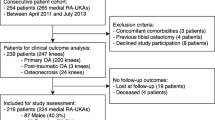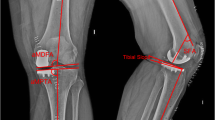Abstract
Purpose
Unicompartmental knee arthroplasty (UKA) is effective for treating degenerative joint disease in a single compartment. Robotic-arm-assisted arthroplasty (RAA) has gained popularity and has theoretical benefits of improved outcomes over conventional (CONV) UKA due to the technical precision of bone preparation. This study compares the short-term clinical outcomes, including survivorship and patient-reported functional outcomes, for a series of medial UKAs performed with RAA and CONV.
Methods
One hundred seventy-six consecutive fixed-bearing medial UKAs were retrospectively identified with a minimum follow-up of 2 years. One hundred and eighteen CONV and 58 RAA were performed. Pre- and post-operative SF12, WOMAC, and KSS Functional Questionnaires were available for all patients.
Results
At 2 years, both groups improved in all functional outcomes, with no significant difference between the RAA and CONV cohorts. However, the RAA cohort had a significantly longer operative time (p < 0.001) and a higher early revision rate than the CONV group (7 [12.0%] vs. 7 [6.8%]; p < 0.05).
Conclusions
These results demonstrate that at short-term follow-up of 2 years, RAA was not superior to CONV in terms of functional scores and instead was associated with greater operative time and cost and lower survivorship. Therefore, at this time usage of RAA in UKA is not recommended compared to conventional UKA. Longer term studies are necessary to draw conclusions about the overall outcomes of RAA compared to CONV.
Level of evidence
III.

Similar content being viewed by others
References
Association AO (2017) Annual report: hip and knee replacement. Sydney. Australia, Australian Orthopaedic Association. 2018
Amin AK, Patton JT, Cook RE, Gaston M, Brenkel IJ (2006) Unicompartmental or total knee arthroplasty?: results from a matched study. Clin Orthop Relat Res 451:101–106
Batailler C, White N, Ranaldi FM, Neyret P, Servien E, Lustig S (2018) Improved implant position and lower revision rate with robotic-assisted unicompartmental knee arthroplasty. Knee Surg Sport. https://doi.org/10.1007/s00167-018-5081-5
Bell SW, Anthony I, Jones B, MacLean A, Rowe P, Blyth M (2016) Improved accuracy of component positioning with robotic-assisted unicompartmental knee arthroplasty: data from a prospective, randomized controlled study. J Bone Joint Surg 98(8):627–635
Berger RA, Meneghini RM, Jacobs JJ, Sheinkop MB, Della Valle CJ, Rosenberg AG, Galante JO (2005) Results of unicompartmental knee arthroplasty at a minimum of ten years of follow-up. J Bone Joint Surg 87(5):999–1006
Bernardoni HS, Illgen R (2016) Manual versus robotic assisted unicompartmental knee arthroplasty: a comparison of validated clinical outcomes at 3 years, in 2016 American Association of Hip and Knee Surgeons Annual Meeting, Dallas, TX. 2016
Bruni D, Iacono F, Akkawi I, Gagliardi M, Zaffagnini S, Marcacci M (2013) Unicompartmental knee replacement: a historical overview. Joints 1(2):45
Cobb J, Henckel J, Davies B et al (2006) Hands-on robotic unicompartmental knee replacement: a prospective, randomised controlled study of the acrobot system. J Bone Joint Surg Br 88(2):188–197
Collier MB, Eickmann TH, Sukezaki F, McAuley JP, Engh GA (2006) Patient, implant, and alignment factors associated with revision of medial compartment unicondylar arthroplasty. J Arthroplasty 21(6):108–115
Dunbar NJ, Roche MW, Park BH, Branch SH, Conditt MA, Banks SA (2012) Accuracy of dynamic tactile-guided unicompartmental knee arthroplasty. J Arthroplasty 27(5):803–808
Dyrhovden GS, Lygre SHL, Badawy M, Gøthesen Ø, Furnes O (2017) Have the causes of revision for total and unicompartmental knee arthroplasties changed during the past two decades? Clin Orthop Relat Res 475(7):1874–1886
Haaker R, Konermann W (2013) Computer and template assisted orthopedic surgery. Springer, Berlin
Insall J, Aglietti P (1980) A five to seven-year follow-up of unicondylar arthroplasty. J Bone Joint Surg Am 62(8):1329–1337
Kayani B, Konan S, Huq SS, Tahmassebi J, Haddad FS (2018) Robotic-arm assisted total knee arthroplasty has a learning curve of seven cases for integration into the surgical workflow but no learning curve effect for accuracy of implant positioning. Knee Surg Sports Traumatol Arthrosc. https://doi.org/10.1007/s00167-018-5138-5
Kini SG, Sathappan SS (2013) Robot-assisted unicondylar knee arthroplasty: a critical review. Orthopedics 1(1):4
Kozinn SC, Scott R (1989) Unicondylar knee arthroplasty. J Bone Joint Surg Am 71(1):145–150
Laurencin CT, Zelicof SB, Scott RD, Ewald FC (1991) Unicompartmental versus total knee arthroplasty in the same patient. A comparative study. Clin Orthop Relat Res 273:151–156
Liabaud B, Patrick DA, Geller JA (2013) Higher body mass index leads to longer operative time in total knee arthroplasty. J Arthroplasty 28(4):563–565
Liddle AD, Pandit H, Judge A, Murray DW (2015) Patient-reported outcomes after total and unicompartmental knee arthroplasty: a study of 14,076 matched patients from the National Joint Registry for England and Wales. Bone Joint J 97(6):793–801
Liow MHL, Goh GSH, Wong MK, Chin PL, Tay DKJ, Yeo SJ (2017) Robotic-assisted total knee arthroplasty may lead to improvement in quality-of-life measures: a 2-year follow-up of a prospective randomized trial. Knee Surg Sports Traumatol Arthrosc 25(9):2942–2951
Lombardi AV, Berend KR, Walter CA, Aziz-Jacobo J, Cheney NA (2009) Is recovery faster for mobile-bearing unicompartmental than total knee arthroplasty? Clin Orthop Relat Res 467(6):1450–1457
Lonner JH, John TK, Conditt MA (2010) Robotic arm-assisted UKA improves tibial component alignment: a pilot study. Clin Orthop Relat Res 468(1):141
Newman JH, Ackroyd CE, Shah NA (1998) Unicompartmental or total knee replacement? Five-year results of a prospective, randomised trial of 102 osteoarthritic knees with unicompartmental arthritis. J Bone Joint Surg Br 80(5):862–865
Newman J, Pydisetty RV, Ackroyd C (2009) Unicompartmental or total knee replacement: the 15-year results of a prospective randomised controlled trial. J Bone Joint Surg Br 91(1):52–57
Noticewala MS, Geller JA, Lee JH, Macaulay W (2012) Unicompartmental knee arthroplasty relieves pain and improves function more than total knee arthroplasty. J Arthroplasty 27(8):99–105
Novak EJ, Silverstein MD, Bozic KJ (2007) The cost-effectiveness of computer-assisted navigation in total knee arthroplasty. J Bone Joint Surg 89(11):2389–2397
Park SE, Lee CT (2007) Comparison of robotic-assisted and conventional manual implantation of a primary total knee arthroplasty. J Arthroplasty 22(7):1054–1059
Pearle AD, O’Loughlin PF, Kendoff DO (2010) Robot-assisted unicompartmental knee arthroplasty. J Arthroplasty 25(2):230–237
Redmond JM, Gupta A, Hammarstedt JE, Petrakos AE, Finch NA, Domb BG (2015) The learning curve associated with robotic-assisted total hip arthroplasty. J Arthroplasty 30(1):50–54
Riddle DL, Jiranek WA, McGlynn FJ (2008) Yearly incidence of unicompartmental knee arthroplasty in the United States. J Arthroplasty 23(3):408–412
Scott RD, Santore RF (1981) Unicondylar unicompartmental replacement for osteoarthritis of the knee. J Bone Joint Surg 63(4):536–544
Seon JK, Song EK, Park SJ, Yoon TR, Lee KB, Jung ST (2009) Comparison of minimally invasive unicompartmental knee arthroplasty with or without a navigation system. J Arthroplasty 24(3):351–357
Siebert W, Mai S, Kober R, Heeckt PF (2002) Technique and first clinical results of robot-assisted total knee replacement. Knee 9(3):173–180
Sinha RK (2009) Outcomes of robotic arm-assisted unicompartmental knee arthroplasty. J Orthop 38(2):20–22
Sodhi N, Khlopas A, Piuzzi NS, Sultan AA, Marchand RC, Malkani AL, Mont MA (2018) The learning curve associated with robotic total knee arthroplasty. Knee 31(01):17–21
Van der List JP, Chawla H, Joskowicz L, Pearle AD (2016) Current state of computer navigation and robotics in unicompartmental and total knee arthroplasty: a systematic review with meta-analysis. Knee Surg Sports Traumatol Arthrosc 24(11):3482–3495
Walton NP, Jahromi I, Lewis PL, Dobson PJ, Angel KR, Campbell DG (2006) Patient-perceived outcomes and return to sport and work: TKA versus mini-incision unicompartmental knee arthroplasty. J Knee Surg 19(02):112–116
Weber P, Utzschneider S, Sadoghi P, Pietschmann MF, Ficklscherer A, Jansson V, Müller PE (2012) Navigation in minimally invasive unicompartmental knee arthroplasty has no advantage in comparison to a conventional minimally invasive implantation. Arch Orthop Trauma Surg 132(2):281–288
Acknowledgements
The authors would like to acknowledge the following people for their help with data analysis and manuscript editing: Katherine MacCallum, MD and David Patrick, MD.
Funding
No authors received outside funding for the support of this work.
Author information
Authors and Affiliations
Corresponding author
Ethics declarations
Conflict of interest
No author has a conflict of interest directly with this work.
Ethical approval
Full institutional review board approval was obtained for this study.
Additional information
Publisher’s Note
Springer Nature remains neutral with regard to jurisdictional claims in published maps and institutional affiliations.
Rights and permissions
About this article
Cite this article
Wong, J., Murtaugh, T., Lakra, A. et al. Robotic-assisted unicompartmental knee replacement offers no early advantage over conventional unicompartmental knee replacement. Knee Surg Sports Traumatol Arthrosc 27, 2303–2308 (2019). https://doi.org/10.1007/s00167-019-05386-6
Received:
Accepted:
Published:
Issue Date:
DOI: https://doi.org/10.1007/s00167-019-05386-6




